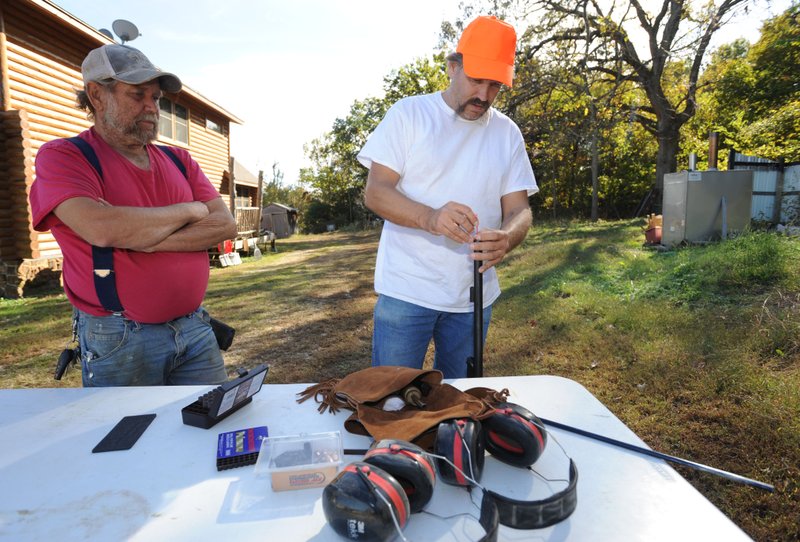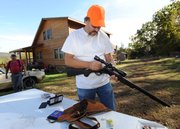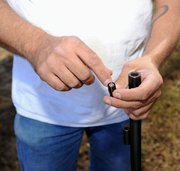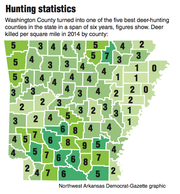Larry Aggus remembers when bagging a deer in Washington County made the news.
"I'm 75 years old, and there was a time in Missouri and Arkansas when it made the local newspaper if somebody even saw a deer up here," said Aggus, referring to the 1950s. He owns Southtown Sporting Goods in Fayetteville, just south of the Springdale city limits. Aggus is also a retired biologist for the U.S. Fish and Wildlife Service.
Over-hunting and destruction of deer habitat drove Arkansas' deer population down to an estimated 1,000 survivors by 1930, according to historical studies by the Arkansas Game and Fish Commission. The commission was created in 1915 but had no power to enforce limits on the taking of game until 1944. A constitutional amendment passed that year also made the agency independent of direct control by elected lawmakers.
It took decades for the state's deer population to recover. When the herds did start coming back, they flourished first in south Arkansas, which has better habitat for deer. As recently as 2005, Washington County hunters brought in less than one-third as many deer a year as any one of several south Arkansas counties, commission records show.
That changed dramatically in 2006. The amount of deer killed by hunters in Washington County grew from 1,423 in the 2005 and early 2006 season to 2,643 the next season, commission figures show. The number had more than doubled to 5,946 by 2012-13.
The figures for Benton County in the same years were 1,085 in 2005-06 season and 4,707 in 2012-13.
The latest figures are from the season that began last year, with 4,500 deer taken in Washington County and 4,398 in Benton County.
Washington County turned into one of the five best deer-hunting counties in the state in a span of six years, figures show. The turnaround went according to plan.
"It was good management, restricting the number of deer you could hunt here until the population built up," Aggus said.
Game and Fish strictly limited the number of deer that hunters could kill in all of what is now commission regions 1 and 1a, which cover Benton and most of Washington counties. Joe Birmingham of Hogeye and Dustin Cunningham of Elkins, both experienced deer hunters in the region, agreed past Game and Fish restrictions now yield a harvest for hunters.
Those hunters went back in the woods this weekend. Deer season for muzzle-loading guns began Saturday. The season for modern rifles starts Nov. 14.
"I didn't always agree with them, but the results prove they were right," Birmingham said. "They restricted hunting on deer that didn't have antlers a few years back, and I thought we wouldn't be able to get a deer. Now I have to say that's one of the best things they've ever done."
While the commission appreciates the credit and will take it, both nature and Northwest Arkansas landowners contributed to a booming deer population, Game and Fish biologists said.
Northwest Arkansas deer depend heavily on acorns and other highly seasonal forage, said Cory Gray of Monticello, the commission's chief biologist for deer. The deer have enough food to last the year if there's a good crop of acorns. South Arkansas, which "is a deer factory" according to Gray, has a greater variety of plants for deer to eat that gives a more reliable supply of food. A bad year for any particular food source in south Arkansas doesn't leave the deer looking for food.
Northwest's Arkansas' heavily seasonal food supply is called "mass" by biologists.
"You're mass dependent, and you've had excellent mass back to back, back and back," Gray said. "You've had years of it. And that field stuff is high in carbohydrates and is great food for fawning, and it falls right when fawning begins. You've not had a nutrient-stressed winter in several years.
"You've also got a lot of landowners up there who've realized there's a deer population up there now and are doing some wise planning to encourage that" such as setting out food for deer and not disturbing their habitat, Gray said. "It amazes me how the human population is booming up there and now you have a huge deer population too."
Aggus made the same point in a separate interview.
"They get along with people," he chuckled.
Birmingham said farmers have grown more crops such as corn knowing that deer will eat some of it.
"What they're planting caters to wildlife," he said. Property owners are doing the same on smaller tracts too, he said.
Ralph Meeker of Fort Smith is assistant deer biologist for Game and Fish. The agency has no intention of letting the deer population be over-hunted nor letting it grow so big that a bad year for their food supply will cause a crash.
"We keep an eye on it, and a good, sizable population has built up," he said. "It took decades to build up to this point. Really, it started taking off in the 1990s."
"The deer population is prolific once it gets established," Meeker said. "As long as we don't take the gloves off and declare war on them, the population should sustain itself."
No amount of time will remove some of the region's disadvantages, though, Meeker and Gray said. The soil is rocky and thin over much of Northwest Arkansas. One consequence of that is a lack of ground cover like the pine thickets so favored by deer in south Arkansas.
"A fawn spends the first three or four weeks of its life hiding," Gray said. "The mother goes and feeds, then comes back and nurses her young. Well, the forests up there are all under a canopy with very little on the ground. You have plenty of trees, but look through the gaps between them and you can see for a hundred yards. There's nowhere to hide."
At least deer in the region have the advantage of being able to stay in a safe, remote region once they find one, according to Birmingham.
"When those acorns fall, there's plenty of food right where they're at," he said. "They don't have to go far to eat. They can eat and lay down, and when they're not traveling they're harder to ambush."
A big disadvantage for hunters in Northwest Arkansas is piecemeal land ownership, Birmingham and Cunningham said in separate interviews. In south Arkansas, timber companies own tracts of thousands of acres and lease the hunting rights to private hunting clubs.
"You either have to know somebody or just go knock on doors, asking for a place to hunt," Cunningham said. "There's absolutely not as many spots as there are in south Arkansas. The people who do know a good spot and have permission to hunt there keep the location close to the their vest as far as telling anybody else."
Cunningham, 32, has hunted deer in the region since he was 12.
"You used to be able to pull over to the side of the road and go hunting," he said. "Now there's buildings and houses everywhere, and construction. If there's a large hunting club around, I'm not aware of it. If somebody could find the land for one there would be an overwhelming demand for that."
NW News on 10/18/2015




